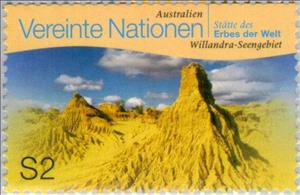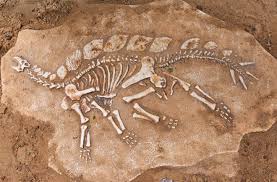Stamp: Willandra Lakes Region, Australia (World Heritage 1981) (UNO Vienna 1999)
Willandra Lakes Region, Australia (World Heritage 1981) (UNO Vienna 1999)
01 January (UNO Vienna ) within release World heritage goes into circulation Stamp Willandra Lakes Region, Australia (World Heritage 1981) face value 2 Austrian schilling
| Stamp Willandra Lakes Region, Australia (World Heritage 1981) in catalogues | |
|---|---|
| Michel: | Mi:NT-WN 286 |
Stamp is square format.
Also in the issue World heritage:
- Stamp - Uluru National Park, Australia (World Heritage 1987) face value 4.50;
- Stamp - Tasmanian Wilderness, Australia (World Heritage 1982) face value 6.50;
- Stamp - Tasmanian Wilderness, Australia (World Heritage 1982) face value 1;
- Stamp - Wet Tropics of Queensland, Australia (World Heritage 1988) face value 1;
- Stamp - Great Barrier Reef, Australia (World Heritage 1981) face value 1;
- Stamp - Uluru National Park, Australia (World Heritage 1987) face value 2;
- Stamp - Kakadu National Park, Australia (World Heritage 1981) face value 2;
- Stamp - Willandra Lakes Region, Australia (World Heritage 1981) face value 2;
Stamp Willandra Lakes Region, Australia (World Heritage 1981) it reflects the thematic directions:
A landscape is the visible features of an area of land, its landforms and how they integrate with natural or man-made features. A landscape includes the physical elements of geophysically defined landforms such as (ice-capped) mountains, hills, water bodies such as rivers, lakes, ponds and the sea, living elements of land cover including indigenous vegetation, human elements including different forms of land use, buildings and structures, and transitory elements such as lighting and weather conditions. Combining both their physical origins and the cultural overlay of human presence, often created over millennia, landscapes reflect a living synthesis of people and place that is vital to local and national identity. The character of a landscape helps define the self-image of the people who inhabit it and a sense of place that differentiates one region from other regions. It is the dynamic backdrop to people’s lives. Landscape can be as varied as farmland, a landscape park, or wilderness. The earth has a vast range of landscapes, including the icy landscapes of polar regions, mountainous landscapes, vast arid desert landscapes, islands and coastal landscapes, densely forested or wooded landscapes including past boreal forests and tropical rainforests, and agricultural landscapes of temperate and tropical regions.
A fossil (from Classical Latin fossilis, lit. 'obtained by digging') is any preserved remains, impression, or trace of any once-living thing from a past geological age. Examples include bones, shells, exoskeletons, stone imprints of animals or microbes, objects preserved in amber, hair, petrified wood and DNA remnants. The totality of fossils is known as the fossil record. Though the fossil record is incomplete, numerous studies have demonstrated that there is enough information available to give a good understanding of the pattern of diversification of life on Earth. In addition, the record can predict and fill gaps such as the discovery of Tiktaalik in the arctic of Canada
The United Nations Educational, Scientific and Cultural Organization (UNESCO; pronounced /juːˈnɛskoʊ/) is a specialized agency of the United Nations (UN) with the aim of promoting world peace and security through international cooperation in education, arts, sciences and culture. It has 194 member states and 12 associate members,as well as partners in the non-governmental, intergovernmental and private sector. Headquartered in Paris, France, UNESCO has 53 regional field offices and 199 national commissions



